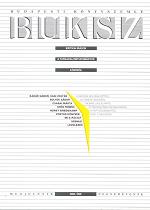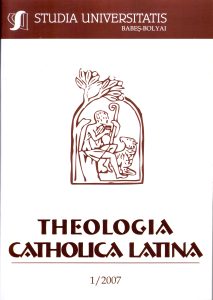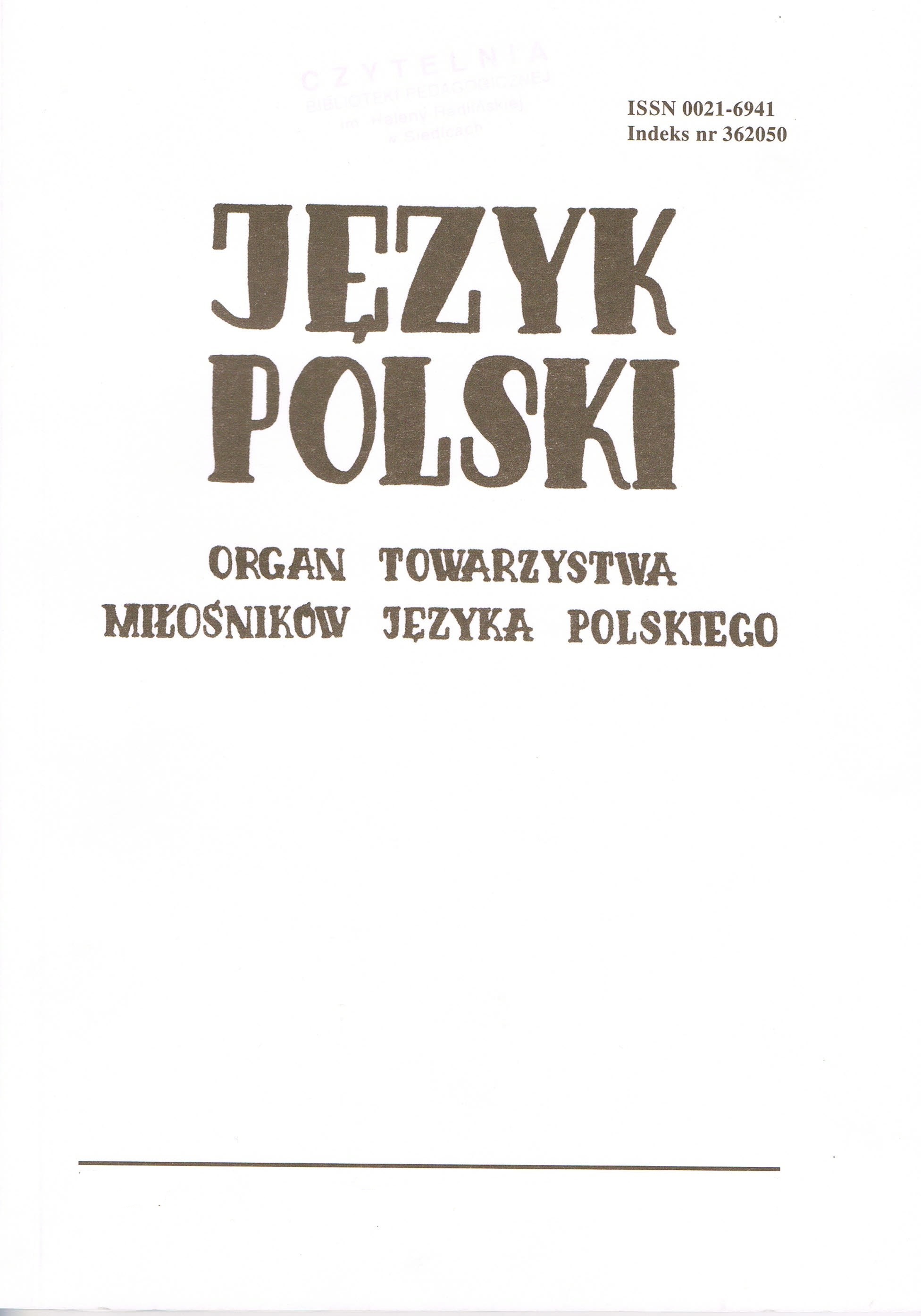
Human Rights
Egyes emberi jogok...
Keywords: human rights theory; law
A critical review on Gábor Halmai's and Attila Gábor Tóth's (eds.) "Emberi jogok [Human Rights]".
More...
Keywords: human rights theory; law
A critical review on Gábor Halmai's and Attila Gábor Tóth's (eds.) "Emberi jogok [Human Rights]".
More...
Keywords: history of fine arts
A study on the History of Fine Arts as the Science of Image.
More...
Keywords: correspondence; István Schütz; Zsolt Simon; Erzsébet Szalai; Tibor Schwendtner
Letter by István Schütz, response by Zsolt Simon; letter by Erzsébet Szalai; letter by Tibor Schwendtner, reponse by Csaba Olay.
More...

Modernity challenges contemporary faith in various ways. In this context, this article wants to provide an outline of the tasks for modern theology and theologians. There are some underlying assumptions. First, the transmission of faith in the 21st century cannot do without an active appropriation by the believers themselves. Second, theologians, among others, should facilitate this process of appropriation by providing a large variety of different ‘products’. To that extent, a critical yet constructive and sympathetic dialogue with modernity remains an essential notion. The Thomistic perspective on nature and grace, adopted here, facilitates this much needed attitude of dialogue which may take place on many different levels. Furthermore, participation in the public debate, feminisation and themes relating to the social question are identified as important Church issues. They challenge modern theology and theologians to develop activist, world open spiritualities next to quietist, contemplative versions thereof. Meanwhile, Christian tradition provides many examples.
More...
Thomas L. BRODIE, Dennis MACDONALD, Stanley E. PORTER (eds.): The Intertextuality of the Epistles: Explorations of Theory and Practice (New Testament Monographs 16), Sheffield Phoenix, Sheffield, 2006, xvi + 311pp., ISBN 1905048629 (hardcover).
More...
Hans-Josef KLAUCK: Apokryphe Apostelakten. Eine Einführung, Katholisches Bibelwerk, Stuttgart, 2005, 292 pp., ISBN 978-3-460-33023-8 (paperback).
More...
Die Römisch-Katholische Theologische Fakultät der Babeş-Bolyai Universität feierte 2006 das zehnjährige Jubiläum ihres Bestehens. Diese Feier war Anlass für die Organisation einer Theologischen Tagung, die dem Thema „Theologie in Siegenbürgen: gestern, heute und in der Zukunft“ gewidmet war. Im Folgenden sind einige, von den an dieser Tagung gehaltenen Ansprachen publiziert.
More...
Der vorliegende Artikel stellt ein Plädoyer für die Legitimität der Kirche und Theologie in der modernen Gesellschaft. Das Ende des 20. Jahrhunderts ist eine von dem Streit zwischen Postmoderne und Moderne gekennzeichneten Epoche. In dieser neuen Epoche erscheint ein neuer Zeitgeist, der die Werte und das klassische Modell über die „humanitas“ in Frage stellt. Damit tritt ein neues Zeitalter der Geschichte ein, das vor allem durch die Pluralität der Erfahrungsformen und der Wahrheit gekennzeichnet ist. Nun assistieren wir am Zerfall von Glauben und Wissen. Es entsteht eine starke Kluft zwischen Religion und Philosophie (beide auch als Hauptformen der Kultur verstanden); zwischen Theologie und Metaphysik (als Formen des hermeneutischen Vorgehens) und nicht zuletzt zwischen der Kirche und dem Kulturleben. Es wird nach einer missionarischen Kirche und Theologie verlangt, die sich auf die göttliche Präsenz in der Welt besinnen und sich verantwortungsvoll und aktiv im Prozess gesellschaftlicher Umwand¬lungen engagieren.
More...
The paper provides a brief overview of the Catholic theological education in Hungary, its organisation, divisions, and topics. A major restructuring began only in the seventies and was finalised only in the mid-nineties. It was only then that staff and student numbers, a logically structured curriculum, and the publication of Hungarian theological textbooks approached the situation in other countries. The establishment of a Catholic university was certainly a highly significant event, even if it was not accompanied by any growth in the size of the Faculty of Theology. Another important development was the foundation of the Institute of Studies for the Religious, which was the first theological institution to encourage a comprehensive study of the history of religious orders in Hungary. Large numbers of lay students now study at the metropolitan and provincial theological schools. Their similarly large presence in the postgraduate sphere has established them as the dominant new force in comparison with which the number of seminarians and religious who are involved in theological study can only drop. Hungarian higher education, the theological sphere included, is uniformly regulated. The system of financial support for theological institutions and students, however, is fragile, and student numbers show no sign of increasing any further.
More...
The essay focuses on the Western European debates on the role of theology and religious studies, using as reference point the trends at Radboud University (Nijmegen), and the approaches of scholars of this university (J. van der Ven, G. Essen). The growing interest in religious studies has to do with institutional differentiation and globali¬sation. In Western Christian society Christian theology no longer provides the overarching theory from which universal knowledge is described. These phenomena explain the growing interest in religious studies. Nonetheless, the simplistic view that opposes religious studies, as aiming at objectivity, to theology as partisan and subjective (R. Kloppenborg), needs to be revised. Therefore the previous models of dependence or opposition, used to describe the relationship between theology and religious studies, should be replaced by the model of complementarity. Both theology and religious studies should engage themselves in Christianity and the other religions, but each one from a different perspective. The material object of theology and religious studies is the same for both disciplines. However the formal object of theology is taken from an internal (“emic”) perspective, while religious studies take a strict external (“ethic”) perspective. Although scholarly approaches may adopt different premises, they agree in advocating that theology and religious studies are comple¬mentary.
More...
Keywords: word-formation; expressive lexis; colloquial Polish; Polish local dialects
The article concerns the occurrence in the Polish colloquial language of the new type of word formations with the -ok suffix. The occurrence of this suffix results from the influence of Polish local dialects. The -ok formant to which this article refers is the result of phonetic changes to the -ak suffix. In certain local dialects this suffix is pronounced with the vowel that is very similar or even identical to "o", as a result of which -åk > -ok. The derivatives such as wsiok, jabcok, pijok are more and more popular in colloquial communication. Numerous examples of such formations may be found in the Internet language. Words with the -ok suffix also appear in literary texts and in the press, which confirms the fact that the formant has become very popular.
More...
Keywords: Polish-English cognates; sound changes; Grimm’s Law; apophony; Verner’s Law
The present paper is the second in the series devoted to the traces of Grimm’s Law in Polish-English cognates. Like the first, it concentrates on the change of PIE *p to PGmc *f, but this time the focus is on the cases which pose some methodological difficulties. Firstly, the paper discusses less transparent juxtapositions of cognates which descend from incongruous morphological structures or etymons exhibiting different ablaut grades, but sharing the same root. Secondly, the paper presents the phonological developments which obscured the sound change of PIE *p to PGmc *f (such as Verner’s Law, the change of PIE *kw > Pre-Gmc *p, simplification of consonant clusters, or analogical changes).
More...
Keywords: proper names; chrematonimy; naming tendencies
The main aim of the present work is an attempt to review and classify the proper names for the “Aquarium and Terrarium” pavilion. The names were submitted by the inhabitants of Bydgoszcz within the “Competition for the name of the pavilion in the Polish Fauna Garden in Bydgoszcz”, organized in November 2012 by the Mayor of Bydgoszcz. The typology is based primarily on the semantic criterion according to which the individual names were included in specific groups with common or similar motivation. Also the structural criterion was not without significance in the classification of the names. The submitted proposals may be considered chrematonyms. The submitted proposals of names constitute a rich and varied set, they are a result of a variety of choices in which information about the word is connected with the information about the object, but also they go beyond the object itself on the basis of associations with the mental images (imaginative) referring to various pieces of extra-linguistic reality. In many cases they refer in a wide range to the communicative competence of the Polish language users, to their knowledge, firmly embedded in the socio-cultural context, which allows them to use various sign systems functioning in a certain community. Literature, cinema, television and the Internet can be such systems. A characteristic feature of the submitted nominations is also crossing the linguistic boundaries, which results in forming multilingual names. On the one hand the submitted names are original and in many cases reveal the language creativity of their authors, on the other hand — they reflect broader trends in naming.
More...
Jolanta Kowalewska-Dąbrowska, Tekst poetycki jako przedmiot badań lingwistycznych. Teoria i praktyka w kontekście semantycznych interpretacji utworów poetyckich Janusza Pasierba oraz Anny Kamieńskiej, by R. Pawłowska Rafał Zarębski, Rzeczownikowe prefiksy obcego pochodzenia w historii języka polskiego, by A. Kawecka Małgorzata Marcjanik, Słownik językowego savoir-vivre’u, by B. Ścigała-Stiller Elżbieta Sękowska, Język emigracji polskiej w świecie. Bilans i perspektywy badawcze, by. A. Masiewicz
More...Keywords: Francis Bacon; idols of Baconian scholarship; Baconianism(s); Bacon’s legacy
The purpose of this introductory essay is to situate some of the major questions relating to Bacon’s legacy and various forms of early modern Baconianism(s) in the wider context of Bacon studies, especially in view of recent developments in this field. I claim that one can see in the troubled historical reception of Francis Bacon interesting historiographical and philosophical problems, as well as a fascinating case-study of intellectual history. I offer a way of dealing with the complexity of the field by identifying four “idols” of Baconian scholarship. I show in what ways such “idols” can be held responsible for the conflicting reception of Bacon’s works and projects and for some related issues in the investigation of Bacon’s legacy and “followers.” I am also using these “idols” to chart a relatively little explored territory and to point towards new and recently developed directions of research. In the last part of this introductory essay I attempt a survey of themes and research questions relating to Bacon’s legacy and early modern Baconianism(s) as seen from the perspective of recent developments in the field. In this way, I aim to place in a wider context the studies contained in this special issue.
More...Keywords: husbandry; Gabriel Plattes; Hartlib Circle; technologies of amelioration; technologies of salvation
In this paper I will try to investigate some of the ways in which husbandry, a recurrent topic in Gabriel Plattes’ works, was considered to be the recipe for bringing salvation in religious and economic manner. I will argue that proper methods of husbandry advocated by Gabriel Plattes, accompanied by a technological vision of amelioration, have been able to provide the foundation for healing the land and the human soul. Technological innovation, good measures of husbandry of the land and of the soul are able to ameliorate the economic estate of the nation and also to restore the human condition held prior to Fall. Experimental husbandry of the land and of the soul includes: agricultural innovation which could restore the plenty of the Garden of Eden, medicine which could solve the problems of disease, education reformation which could cultivate the young, and general economic reform which could bring undreamed of prosperity. Inspired from the Baconian tradition, Plattes reformulates the view on husbandry, promoting a new type of ‘integrated science’ able to cultivate the land and the human soul as well. Plattes contribution lies in providing a number of ‘technologies of amelioration’ for the material of Creation (soil, plants, human beings), technologies of salvation in an economic and religious manner.
More...Keywords: Perspectives on Science; Francis Bacon; medicina mentis; New Atlantis
The edition of this summer’s number of Perspectives on Science is dedicated to a close-up of a particular intellectual context which favored the emergence of Francis Bacon’s works on natural philosophy in general and his epistemological account in particular. In the era of great upheavals and general reform Bacon assumed an important part: that of Reformer and Curer of the human mind. He aimed at freeing the faculties of the mind-imagination, memory, judgment, reason, from the false and perilous bridles of vain speculations, rash generalizations and idolatrous tendencies. The wide-spread acknowledgment of Bacon’s theory of error is taken up and elaborated in the edition dedicated to Francis Bacon and his “medicine of the mind” in an attempt to answer some challenging questions about the tradition which informs Bacon’s entire oeuvre.
More...Keywords: De augmentis scientiarum; The Advancement of Learning; Instauratio magna,
The Two Bookes of Francis Bacon of the Proficience and Advancement of Learning,published for the first time in 1605, is one of the first works belonging to what is known as modern philosophy. It is the first important work of philosophy of Francis Bacon, written in the form of a letter to King James of England and Scotland and expanded in a Latin edition in 1623, De augmentis scientiarum. About this book one can affirm what Bacon said about the technical inventions of his time: it has “changed the whole face and state of things throughout the world”1. Thus, this first Romanian edition of the Advancement of Learning, artfully and accurately translated by Dana Jalobeanu and Grigore Vida, is truly praiseworthy, by facilitating and revealing to the Romanian reader some of the major transformations of modern thought entailed in Bacon’s philosophy.
More...Keywords: Locke; travel literature; species; natural kinds; taxonomy; classification; Bacon
This paper examines the way in which Locke’s deep and longstanding interest in the non-European world contributed to his views on species and their classification. The evidence for Locke’s curiosity about the non-European world, especially his fascination with seventeenth-century travel literature, is presented and evaluated. I claim that this personal interest of Locke’s almost certainly influenced the metaphysical and epistemological positions he develops in the Essay. I look to Locke’s theory of species taxonomy for proof of this. I argue that Locke uses evidence gathered from the non-European world to (1) show that in taxonomizing objects we rely on their sensible qualities rather than their real essences and to (2) undermine Scholastic Aristotelian views about a mind-independent species/genera structure to the world.
More...